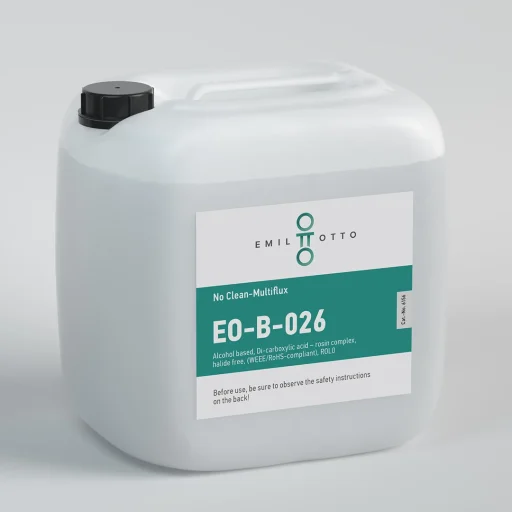Wave, selective and manual soldering processes, strand tinning
No Clean-Flux, alcohol-based
Di-carboxylic acid resin complex, halide-free (WEEE/RoHS-compliant) [OPS-compatible]
Type ISO 9454: 1131 // DIN-EN 61190-1-1 (according to J-STD-004): L0 (IPC : ROL0)

| Appearance: | Colorless to amber-colored, clear liquid |
| Solids content: | 4.5 - 5.3 wt.-% |
| Acid number: | 32 - 38 mg KOH/g |
| Halogenide-free: | Yes |
| Resinous: | Yes |
| Activators: | Di-carboxylic acid-resin complex |
| Density at 20 °C: | 0.799 (+/- 0.004) g/ml |
| Flash point: | 12 °C |
| Solvent: | short-chain alcohols |
| Flash point: | 95 % |
| Durability: | 12 months |
| Storage conditions: | cool and dry at 5 - 25 °C |
| Working temperature: | at room temperature (20 - 25 °C) |
EO-B-026 is a flux of the latest generation. It is a high-performance no-clean flux based on alcohol with dicarboxylic acid activator complex and rosin. This flux was developed for selective and wave soldering processes as well as for dip soldering processes and strand tinning. It can be used with all standard application methods (except foaming). EO-B-026 is completely corrosion-free.
Instructions for use:
This flux is very versatile and OPS-compatible. Good results are achieved with manual, wave and selective soldering. The general rule of using flux as low as possible also applies to this product.
Recommendation from practice:
Spray fluxing: If possible, first try out a quantity of 15 - 30 ml/min. and observe the distribution of the flux. Then correct the quantity. Air pressure: 18 - 20 l/min.
Preheat (when using a preheating system): The temperature on the top side of the PCBs should be 80 - 110 °C when entering the solder wave, depending on the type of PCB, layout, etc. When using lead-free solders, preheating temperatures of 100 - 130 °C on the top side are possible.